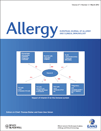Galectin-9 induced by dietary synbiotics is involved in suppression of allergic symptoms in mice and humans
Edited by: Hans-Uwe Simon
Abstract:
Background:
Prebiotic galacto- and fructo-oligosaccharides (scGOS/lcFOS) resembling non-digestible oligosaccharides in human milk reduce the development of atopic disorders. However, the underlying mechanisms are still unclear. Galectins are soluble-type lectins recognizing β-galactoside containing glycans. Galectin-9 has been shown to regulate mast cell degranulation and T-cell differentiation. In this study, the involvement of galectin-9 as a mechanism by which scGOS/lcFOS in combination with Bifidobacterium breve M-16V protects against acute allergic symptoms was investigated.
Methods:
Mice were sensitized orally to whey, while being fed with a diet containing scGOS/lcFOS and Bifidobacterium breve M-16V (GF/Bb) or a control diet. Galectin-9 expression was determined by immunohistochemistry in the intestine and measured in the serum by ELISA. T-cell differentiation was investigated in the mesenteric lymph nodes (MLN) as well as in galectin-9-exposed peripheral blood mononuclear cells (PBMC) cultures. Sera of the mice were evaluated for the capacity to suppress mast cell degranulation using a RBL-2H3 degranulation assay. In addition, in a double-blind, placebo-controlled multicenter trial, galectin-9 levels were measured in the sera of 90 infants with atopic dermatitis who received hydrolyzed formulae with or without GF/Bb.
Results:
Galectin-9 expression by intestinal epithelial cells and serum galectin-9 levels were increased in mice and humans following dietary intervention with GF/Bb and correlated with reduced acute allergic skin reaction and mast cell degranulation. In addition, GF/Bb enhanced Th1- and Treg-cell differentiation in MLN and in PBMC cultures exposed to galectin-9.
Conclusions:
Dietary supplementation with GF/Bb enhances serum galectin-9 levels, which associates with the prevention of allergic symptoms.




